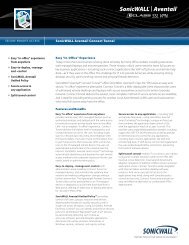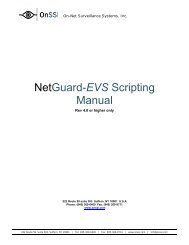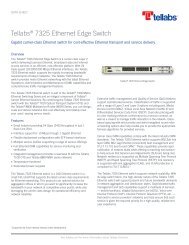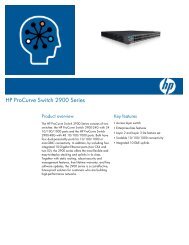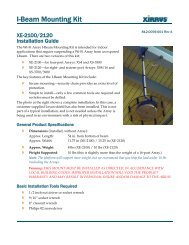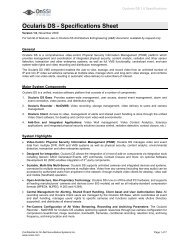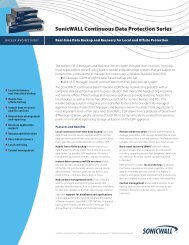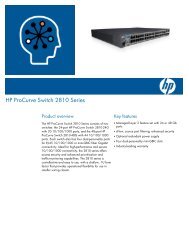HP ProCurve Networking Datasheets - Moonblink
HP ProCurve Networking Datasheets - Moonblink
HP ProCurve Networking Datasheets - Moonblink
You also want an ePaper? Increase the reach of your titles
YUMPU automatically turns print PDFs into web optimized ePapers that Google loves.
<strong>HP</strong> <strong>ProCurve</strong> Access Point 530<br />
• Adjustable output power: controls cell size for high-density<br />
access point deployments<br />
• IEEE 802.3af Power over Ethernet support: simplifies deployment<br />
and dramatically reduces installation costs by helping to<br />
eliminate the time and cost involved in supplying local power at<br />
each access point location<br />
• Link Layer Discovery Protocol (LLDP): enables real-time mapping<br />
of nodes to switch ports; LLDP (IEEE 802.1AB) industry-standard<br />
discovery protocol automatically populates both the LLDP and<br />
proprietary discovery MIBs for net management systems<br />
dependent on these MIBs<br />
Security<br />
• Up to 16 BSSIDs per radio with separate VLAN, security, and<br />
authentication: permits network administrators to control user<br />
access to network resources based on user authentication and<br />
level of trusted security between the client and access point<br />
• Access point authentication: enables secure authentication of the<br />
<strong>ProCurve</strong> Access Point 530 on network ports protected by IEEE<br />
802.1X port-based authentication<br />
• Choice of IEEE 802.11i, Wi-Fi Protected Access 2 (WPA2), or WPA:<br />
locks out unauthorized wireless access by authenticating users<br />
prior to granting network access; robust Advanced Encryption<br />
Standard (AES) or Temporal Key Integrity Protocol (TKIP)<br />
encryption secures the data integrity of the wireless traffic<br />
• <strong>HP</strong> <strong>ProCurve</strong> Identity Driven Manager (IDM) security and access<br />
control:<br />
– Per-user ACLs: permit or deny user access to specific network<br />
resources based on user identity and time of day, allowing<br />
multiple types of users (employees, visitors, temporary<br />
workforce) on the same network to access specific network<br />
services without risk to network security or unauthorized<br />
access to sensitive data<br />
– Automatic VLAN assignment: automatically assigns users to<br />
the appropriate VLAN based on their identity, community, and<br />
time of day<br />
– Rate limits: automatically applies ingress rate limits to user<br />
traffic based on identity, community, and time of day<br />
• Web authentication: provides authentication for browser-based<br />
wireless clients. Built-in login, welcome, and failure Web pages<br />
assist users through the login process.<br />
• IEEE 802.1X: provides port-based user authentication with<br />
support for Extensible Authentication Protocol (EAP), TLS, TTLS,<br />
SIM, GTC, and PEAP, with choice of AES, TKIP, and static or<br />
dynamic WEP encryption for protecting wireless traffic between<br />
authenticated clients and the access point<br />
• Local RADIUS authentication: enables “enterprise-grade” IEEE<br />
802.11i (WPA2) wireless security for small wireless LAN<br />
networks; serves as backup authentication in the event primary<br />
and secondary network RADIUS servers are unavailable due to<br />
network disruption. The local RADIUS authentication feature<br />
supports up to 100 user accounts.<br />
• RADIUS-based MAC authentication: a wireless client is<br />
authenticated with a RADIUS server based on the MAC address<br />
of the client; this is useful for clients that have minimal or no<br />
user interface<br />
• Local MAC authentication: deny or allow network access based<br />
on wireless client MAC address, which is compared to a<br />
database stored on the access point<br />
• MAC address lockout: prevents configured particular MAC<br />
addresses from connecting to the network<br />
• Local wireless bridge client traffic filtering: when enabled,<br />
prevents communication between wireless devices associated<br />
with the same access point<br />
• Neighbor access point (rogue AP) and ad hoc wireless network<br />
detection: Periodic scanning is provided for neighboring access<br />
points and ad hoc wireless networks. Information collected<br />
during the scan, including BSSID, SSID, channel, RSSI, security<br />
setting, and radio type (IEEE 802.11b, b/g, or a mode), is<br />
captured for each wireless device detected. If configured, the<br />
access point can enter dedicated scan mode to provide<br />
continuous scanning of the surrounding RF environment.<br />
• Closed system: restricts broadcast of SSID as a security measure<br />
to conceal presence of the wireless network; access point does<br />
not respond to the wireless client probe request of “ANY”<br />
• Secure management access: all access methods—CLI, GUI, or<br />
MIB—are securely encrypted through SSHv2, SSL, and/or<br />
SNMPv3<br />
• Management VLAN: segments traffic to and from management<br />
interfaces, including CLI/telnet, Web browser interface, and<br />
SNMP<br />
203



